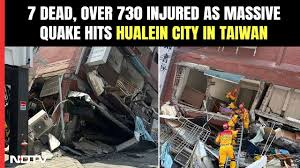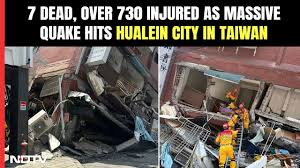7 Dead, 730 Injured in Taiwan’s Strongest Earthquake in 25 Years

Credit: You Tube News
03.04.2024: On Wednesday, Taiwan experienced a devastating earthquake that claimed the lives of seven individuals and left approximately 730 injured. This powerful seismic event caused extensive damage to numerous buildings and triggered tsunami alerts that reached as far as Japan and the Philippines before being lifted.
Authorities have labeled this earthquake as the most potent to hit the island in several decades and have cautioned about the possibility of additional tremors in the coming days. According to Wu Chien-fu, the director of Taipei’s Central Weather Administration’s Seismology Center, the earthquake’s shallow depth and proximity to land resulted in it being felt across Taiwan and its surrounding offshore islands.
Fortunately, Taiwan’s strict building codes and disaster preparedness measures helped mitigate the extent of the catastrophe, considering the island’s frequent encounters with earthquakes due to its location near the convergence of two tectonic plates.
Wu highlighted that this earthquake ranked as the strongest since the devastating 7.6-magnitude quake in September 1999, which claimed the lives of approximately 2,400 individuals, marking it as the deadliest natural disaster in Taiwan’s history.
The recent magnitude-7.4 earthquake struck just before 8:00 am local time, with its epicenter located 18 kilometers south of Hualien City at a depth of 34.8 kilometers, according to the United States Geological Survey (USGS).
Tragically, among those affected were individuals on an early-morning hike near Hualien City, where three people lost their lives due to boulders dislodged by the quake. Additionally, a truck driver perished in a landslide while approaching a tunnel in the vicinity.
Images and videos circulated on social media platforms, depicting buildings swaying and structural damages across the country. Local television broadcasts captured the aftermath, showing tilted multi-story buildings and collapsed structures, including a warehouse in New Taipei City.
President Tsai Ing-wen urged coordination between local and central government agencies, with the national army offering support. The National Fire Agency reported the death toll and noted that nearly 60 individuals had been treated for quake-related injuries.
Although initial tsunami warnings were issued for Taiwan, Japan, and the Philippines, these were later lifted as the threat subsided. However, the earthquake’s impact was felt across the region, with reports of tremors in China’s Fujian province, Hong Kong, and other areas
The earthquake briefly disrupted operations at Taiwan Semiconductor Manufacturing Company, the world’s leading chip manufacturer, and halted construction work at various sites.
While earthquakes are a common occurrence in these regions, their severity and resulting damages vary based on factors such as depth and location. The 2011 earthquake in Japan serves as a stark reminder of the potential devastation such events can cause, with significant loss of life and environmental consequences.
This recent earthquake in Taiwan underscores the ongoing need for robust disaster preparedness measures and international cooperation to mitigate the impacts of natural disasters.

